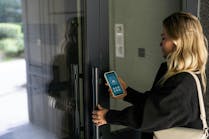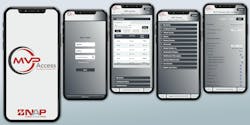Traditionally there’s a ton of work involved with the installation of a conventionally-wired access control system. This and the high-tech nature of today’s systems are the two main reasons why locksmiths often are hesitant to enter the fray. But today it’s really not as bad as it might seem because many of these systems use wireless technology.
“There’s no doubt that installing and programming a full-featured access control system can be intimidating to someone new to the technology,” says John Larkin, Senior Partner with Electronic Systems Consultants of Columbus, Ohio. “But the truth of the matter is, most of the manufacturers out there who make these products utilize wireless technology so you don’t have to install cable. Many of them also have factory training so you send the most likely service technician(s) you have to factory school. When they return, they can begin training the others while on the job.”
Getting a wire from point A to B is not always an easy matter, especially in residential applications where walls must often be “fished” in order to hide the wires. Not only does this require a high level of installation know-how, but it requires a good bit of time, and time costs money, as the old saying goes.
Today, there’s a better way to send and receive data than over a wire, and that‘s through the use of “wireless” technology. In this Locksmith Ledger article we’ll explore the world of wireless as it pertains to electronic security. We’ll pay particular attention to the following four flavors of wireless and we’ll mention a few manufacturers that have taken the time and made the effort to create a completely wireless system.
The four basic wireless technologies we’re going to talk about in this story are:
1. BluetoothTM
2. WiFi (802.11)
3. Cellular & Internet
4. Cloud
There are other wireless technologies available, such as Infrared Light, which offers data speeds up to 100 times faster than traditional WiFi, as well as two low-power radio technologies known as ZigBee and Z-Wave, both which are used in access control. We’ll cover these in another article at a future date.
BluetoothTM and Bluetooth Low EnergyWherever you have a need for electronic locks, wireless is almost always going to be the technology of choice. In fact, entire access control systems are available that provide a full wireless solution where it comes to data communication.
Let’s start with BluetoothTM. Most of us have heard of it, but for those who do not know what it is, it’s a low-cost, low-power radio technology that provides us with an alternative to metallic cable. Most of us know this term from its use with Smartphones. In this case, BluetoothTM often links a Smartphone with a pair of BluetoothTM headphones, a smart watch, or some other device.
BLE (BluetoothTM Low Energy) is similar to BluetoothTM in that they both operate at 2.4GHz. BLE, however, goes to sleep in between transmissions in order to save energy. Using this method, the battery in many BLE devices will last four or five times longer. BLE was actually devised with IoT (Internet of Things) devices in mind.
With regard to BluetoothTM-enabled electronic locks, this tech allows us to sell an access solution to our clients that they can use with their cell phone at the door. Not only does it eliminate the need to install wires from a door to a local controller or centralized access control system equipped with a host computer, but it eliminates the need for the user to manually enter a PIN (Personal Identification Number). Instead a wireless connection sends the data back and forth between the door and the electronics within the lock itself.
The advantage of both versions of BluetoothTM is the relatively low, upfront cost and the fact that it’s so widely accepted by so many manufacturers. It’s a disadvantage that the transmission range is not uniform across the board within and on the perimeter of a home or business. But this is because the radio power is low and subject to environmental conditions, such as temperature, humidity, and construction materials through which these radio signals must travel.
One of the secrets to success with BluetoothTM is knowing the expected transmission distances of the technology. There are four classes of BluetoothTM, each one with an optimal operating distance:
● Class 1: ~300 feet (66 to 98 feet optimal)
● Class 2: ~33 feet (16 to 33 feet optimal)
● Class 3: ~3 feet
● Class 4: ~1/2 foot
Most BluetoothTM devices are Class 2, which means they have an effective range of 16 to 33 feet. When this writer worked for a large, national security firm, it was common knowledge that the Bluetooth transmission range was close to 30 feet between the alarm panel and each electronic lock in the home or business.
Examples of manufacturers and their electronic locks that use BluetoothTM and BLE include the following:
● Yale’s Assure Lock, model YRD226 (http://bit.ly/2wbjd90)
● Schlage Sense Smart Deadbolt (BluetoothTM, http://bit.ly/2NHcDys), with the BR400 WiFi Adapter (http://bit.ly/2Xzdfuy)
● Salto electronic lock (http://bit.ly/2C24FeI) with the XS4 gateway (http://bit.ly/2C3MZ2u)
● August Smart Lock HomeKit Enabled (http://bit.ly/2EMXyIL)
● August Smart Lock Pro + Connect (http://bit.ly/2TyIS8c)
● Kwikset Kevo (http://bit.ly/2TeLloZ)
● Lockly Secure Plus (http://bit.ly/2EN6KwO)
● Friday Lock (https://www.fridaylabs.net/views/home-page.html)
For review, a gateway is basically the same thing as a wireless access point--it’s a transceiver capable of sending and receiving wireless data, in this case 2.4GHz signals via BluetoothTM.
Access Control and WiFi
WiFi and access control are two technologies whose time has come. Today’s 2.4GHz WiFi technology can now be utilized by wireless access control products using a gateway. As mentioned in the previous section, this device effectively connects access control devices, such as a card reader, access controller, etc., to a centralized headend, eliminating the need for metallic cable altogether.
ASSA ABLOY’s CORBIN RUSSWIN and SARGENT brands, for example, makes use of 2.4GHz WiFi technology with their IN120 WiFi lock (http://bit.ly/2XGXSA6). According to ASSA ABLOY, the IN120 uses 802.11 WiFi infrastructure and a flexible set of features that provide a simpler means of installing a small or large access control system. In this case, the IN120 supports HID Mobile Access® powered by ASSA ABBLOY’s Seos®, both of which uses HID® multiCLASS SE® technology.
Not only is this convenient, but it offers up a heightened degree of security than many hardwired systems are capable of providing. In addition, where in the past this type of system was limited in the type of credentials available, here the technology is designed to support multiple credential types.
Additional smart locks that use WiFi include:
● August Pro + Connect (http://bit.ly/2TyIS8c)
● Lockitron Bolt (http://bit.ly/2Uk5VRF)
● Schlage Encode (http://bit.ly/2XCPBgN)
● Nest X Yale Lock with Nest Connect (http://bit.ly/2Uk3EFT)
● Friday Lock (https://www.fridaylabs.net/views/home-page.html)
● Gate Smart Lock (https://getgate.com/)
Cellular and the Internet
The Bolt lock, manufactured by Lockitron, combined with their Bridge module, allows us to connect a client’s door lock with his mobile device. This allows them to receive notifications, read the lock’s activity log (so they know who’s coming and going), as well as lock and unlock any door in the system. In fact, with the Lockitron Bridge device, your clients can gain access to their door lock(s) from anywhere in the world (http://bit.ly/2Uk5VRF).
If you hadn’t figured it out by now, when we talk about cellular connectivity to a Bolt or any other lock from afar, we’re also talking about the Internet. Cellular communication providers, like Verizon, T-Mobile, Sprint, etc., utilize a bridge that links their mobile services to the Internet. In the security business we refer to this as “Remote Access.”
One manufacturer, Connected Technologies Inc. of Crystal Lake, IL (http://bit.ly/2C4rmim), has devised a system that totally eliminates the need for readers and traditional credentials (such as magnetic-stripe and Wiegand cards). The heart of their access control system requires no software to install or maintain and uses a barcode sticker that you affix to the outside of each access controlled door. Using a mobile device with a camera, the user scans the barcode sticker using the Connected Technologies’ ScanPass application and the door opens. By eliminating all those access control readers, you virtually eliminate miles of cable when installing a new system in a large complex.
According to Mike Sherman, managing director of Connected Technologies, “ScanPass is truly unique to the security and access control industry. For a Locksmith, ScanPass opens new doors of opportunity to secure single or multiple doors and also multiple locations, with this industry leading convenience that allows them to differentiate themselves from the competition.”
Leveraging Cloud Technology
The “Cloud” once pertained to the various unknowns associated with almost any process, such as a traditional telephone company’s spider web of communication technologies associated with sending voice and data from point A to B. When used in this manner, it allowed us the privilege of “not” knowing the exact details associated with the communication process. Well, in a very real way, the use of the same term, “Cloud,” carries the same connotation, but as it pertains to data processing and storage at a remote, Cloud-based facility with a connection to the Internet.
Today, “Cloud Computing” is defined as “Internet-based computing in which large groups of remote servers are networked so as to allow sharing of data-processing tasks, centralized data storage, and online access to computer services or resources.” (http://bit.ly/2EyIcpR).
A lot of people, including some technical writers, use this term loosely because, the fact is, the Cloud-based service involves a scalable form of computing and data storage on demand, as opposed to just any kind of off-site data processing system. In other words, you or your client can order additional storage capacity or processing power by using a control panel in a back-office module. Without human intervention, data storage and processing power is increased or decreased by the system and you are charged accordingly.
Why should you offer a Cloud-based service to your clients? The answer is simple: because you charge them a monthly fee to use it. The service company charges you for the using their Cloud-based data processing center, you add a healthy but fair markup, and the client--end user--pays you. RMR (Recurring Monthly Revenue) is the heart of a security company business plan and it should be yours as well and here’s why:
“The cost of licensing and data processing [with storage] can be intimidating when an end user starts a new business. Whether it’s doors in an access control system or cameras in a video surveillance system, each one comes at a yearly cost by way of a Locksmith,” says Electronic Systems Consultant’s Larkin. “The good news for them is that we can offer the same level of service using Cloud processing, but now, instead of the customer paying a huge amount of money on startup, they can rent the service, thereby paying less.”
The other part of this, as mentioned by Larkin, is that the responsibility of maintaining the computers, software, and the licensing renewals is that of the CSP (Cloud Service Provider. Your client can treat the monthly cost as an ongoing operating expense for tax purposes. Otherwise, the cost of the software and networked servers can only be deducted for a few years and then there is no further deductions available.
Companies that provide Cloud-based ACaaS (Access Control as a Service) and VSaaS (Video Surveillance as a Service) include the following companies (this list is not complete):
● Eagle Eye Networks (http://bit.ly/2EK2ZID)
● March Networks (http://bit.ly/2C4OnBX)
● Napco Security Group (http://bit.ly/2EvVNyf)
● Alarm Lock (http://bit.ly/2gMzZFa)
● Bravo (http://bit.ly/2TuRv3D)






